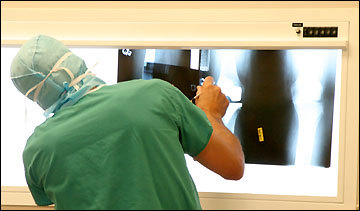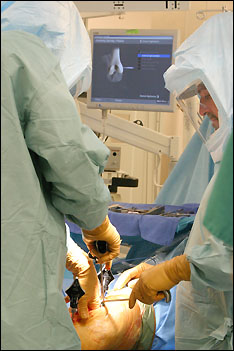New computer navigator used for knee replacements
Dr. Steve Mulawka, an orthopedic surgeon who has been doing knee replacements at PAHCS for the past 15 months, is one of the first 50 doctors in the country to use the computer navigator for knees.
Dr. Mulawka, a partner in St. Cloud Orthopedics who has been coming to PAHCS for 13 years, performed his first knee replacement surgery with the computer navigator at the Paynesville Area Hospital in mid-August. Between Paynesville and St. Cloud, Dr. Mulawka has performed a dozen knee replacements with the new system already.
Knee replacements are only done as a last resort, in the most severest cases where other treatments have failed. The goal is reestablish a straight leg, meaning a straight line from the center of the hip through the center of the knee to the center of the ankle. The straighter the leg, the less wear on the knee, which is true for real and artificial knees, said Dr. Mulawka.
 Before the navigator, using the outside of the leg as a guide for straightness, was not very exact, according to Dr. Mulawka. And even a few degrees of margin mean a great deal in extra wear and tear on the knee.
Before the navigator, using the outside of the leg as a guide for straightness, was not very exact, according to Dr. Mulawka. And even a few degrees of margin mean a great deal in extra wear and tear on the knee.
Orthopedic surgeon Steve Mulawka, M.D., checks x-rays before starting a knee replacement. His new tool is a computer navigator for knees.
After entering the key anatomical landmarks of the patient using a special pointer, the computer can use these landmarks in the hip, knee, and ankle to determine the optimum cuts of the leg bones and the optimum placement of the artificial knee. "Having the computer assist you in those cuts gives you more accuracy and precision in your alignment," said Dr. Mulawka.
The computer navigator also can verify the cuts of the bones (both the femur and tibia must be cut during a knee replacement) and can verify the installation of the artificial knee, leading to a straighter leg for the patient.
Dr. Mulawka compares knees to tire treads, noting that neither knees nor tires wear out overnight. Should your leg, or wheels, be out of alignment, the knee, or tires, will not wear out right away. But a straight leg, like well-aligned wheels, should last longer.
 "The patients won't get immediate benefit from this," said Dr. Mulawka. "It'll take 20 years before they notice that the knee lasts longer. We're looking long term."
"The patients won't get immediate benefit from this," said Dr. Mulawka. "It'll take 20 years before they notice that the knee lasts longer. We're looking long term."
One short-term benefit is that the computer navigator should set the tension in the ligaments better. If an artificial knee is too loose or too tight, it can affect the knee's motion or range, noted Dr. Mulawka, though the limiting factor in the range of an artificial knee is usually the muscles, which gradually get accustomed to the limited range of the old knee and cannot stretch when the knee is replaced.
A new computer navigator helps produce a straighter leg during knee replacements. The first surgery using it was done at PAHCS in August.
Dr. Mulawka thinks the computer navigator is a good complement to the minimum-invasive knee replacements done at PAHCS. In a typical knee replacement, the incision was done on top of the knee and a muscle and tendon were cut to get the knee cap out of the way. In a minimum-invasive knee replacement, he explained, the incision is done on the side of the knee and the knee cap is pushed out of the way without cutting the muscle or tendon.
Patients feel less discomfort, have less pain, and can recover faster with the minimum-invasive procedure, according to Dr. Mulawka, because there are three fewer things to heal in the knee. (Though both procedures still require the cutting of the two leg bones in order to attach the artificial knee.)
With the minimum-invasive knee replacements, patients are ready to go home earlier, said Dr. Mulawka. Even using the criteria that the patient must have independent movement before going home, PAHCS still averages about a three-night stay for minimum-invasive knee replacements when for typical knee replacements the average stay is closer to five nights, said Dr. Mulawka.
Patients will tell you when they are ready for a knee replacement because it is a big commitment, said Dr. Mulawka. To be successful, the patient needs to be diligent in their rehabilitation since the range of motion they achieve in three months is what they will live with for the rest of their life, he added.
People with bad knees are often caught in a Catch-22, said Dr. Mulawka. They lead a sedentary lifestyle due to the pain in their knees, and the sedentary lifestyle often leads to weight gain which causes more stress on their knees. The goal of a knee replacement is to help patients retain a more active lifestyle, added Dr. Mulawka. Increased activity can help patients' cardiac health, their bone density, and their mental health.
A typical knee replacement takes about an hour. With the new machine, the procedure should end up taking an extra 15 minutes to align the leg via computer and verify that alignment.
According to Bev Mueller, acute care administrator for PAHCS, Dr. Mulawka has done around three dozen knee replacements in the past 15 months at PAHCS, since a larger operating room that can handle the orthopedic equipment opened following PAHCS's last building project.
The computer navigator - which costs between $80,000 and $100,000 - has been used in the past for back surgeries but is a new application for knee surgeries, added Mueller. A computer navigator could be a possible future purchase for PAHCS, noted Mueller, but for now Dr. Mulawka will bring the machine with him from St. Cloud.
Contact the author at editor@paynesvillepress.com • Return to News Menu
Home | Marketplace | Community